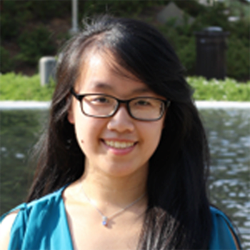 Yellow Jackets Plan for the Red Planet. Sharing a screenshot from their 'home laboratories' are members of MISSION Mars.
Yellow Jackets Plan for the Red Planet. Sharing a screenshot from their 'home laboratories' are members of MISSION Mars.
 |
| Emily Ku Team Lead |
A team of Georgia Tech undergrads took home first place and second place awards in the NASA Revolutionary Aerospace Systems Concepts Academic Linkage (RASC-AL) competition, held entirely online, June 16 – 18.
Placing first in the category of “Best in Theme” and second for “Best Overall” were members of the MISSION Mars”: Emily Ku, (AE), Antoine Paletta (AE), , Alex Hoffman (AE), Elle Smith (AE), Kaushik Manchikanti (AE), Katarine Klitzke (CMPE), Cat Rose (ME).
The 2020 RASC-AL competition tasked teams to use one of five themes to design mission innovations that improve operations in space and on distant bodies. Teams were required to submit a 15-page technical report and a digital poster. They also had to give a 30-minute presentation that was followed up with a live Q&A with the judges.
The Georgia Tech team, “Mission for Impermanent Surface Stay to Investigate our Neighbor, Mars (MISSION Mars),” selected “Short Surface Stay Mars Mission” as its theme.
Competing against Tech in this category were Virginia Tech, University of Maryland, University of Minnesota -Twin Cities, University of Texas – Austin, and the University of Illinois - Urbana Champaign.
 |
| Prof. John Dec MISSION Mars Faculty Coordinator |
MISSION Mars designed a crewed, 30-day mission to Mars that had two main objectives: (1) to have the first human landing on another planet (and safe return to Earth), and (2) to search for life on Mars.
Their mission included conceptualizing two different habitats - an orbiting habitat and a surface habitat- which would all be utilized by four astronauts.
"I think our mission was unique because of our different innovations of torpor stasis, extendable mobile habitat with remote driving capabilities, and design of Mars gliders to collect atmospheric data," described team leader Emily Ku.
They designed their mission architecture to be safe, lower-cost, lower risk overall, but also repeatable.
“We put a lot of emphasis on reusability, so our mission could be a repeatable mission with different exploration zones,” explained Ku.
Interrupted unexpectedly by the COVID 19 crisis, MISSION Mars team members spent the critical weeks leading up to the competition working remotely - spread out across different time zones and continents.
To help the teams adjust to a virtual competition format, RASC-AL organizers allowed teams to use travel stipends to instead purchase cameras, microphones, and headsets for their video presentations.
 |
| The surface habitat (S-Hab) is a pressurized mobile habitat of 14m2 in floor area with a retractable design and folding wheels. |
“It was truly a team effort, each team member specialized in different elements of the design. Seeing the design mature over time, as the team increased their knowledge of spacecraft and mission design, was an amazing experience for me,” said AE professor John Dec, the team's coordinator.
Additional teamwork came in the form of AE graduate students Michael Szostak, Andrew Burrell, Ogun Kargin, and Daniel Sagan.
"We bounced ideas off of them, got edits, and even ran a mock Q&A session to prepare us for the judges Q&A. We couldn't have done it without their help," said Ku.
Though the RASC-AL competition is over, MISSION Mars isn’t finished quite yet.
They will present their technical paper during the 2020 AIAA ASCEND Conference, held virtually in November 2020.
